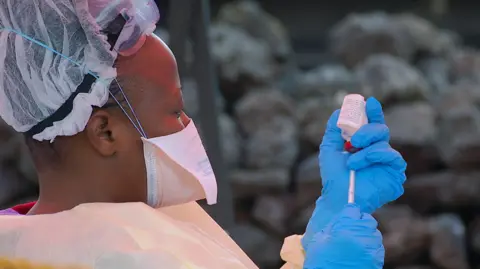China's Guangdong province is grappling with a surge in chikungunya virus cases, reporting over 7,000 infections since July, sparking a response akin to that seen during the COVID-19 pandemic. Foshan city, the epicenter of the outbreak, is treating chikungunya patients in hospitals, with conditions requiring them to remain there under protective mosquito nets until they test negative or complete a week-long stay.
This mosquito-borne virus causes fever and debilitating joint pain, with symptoms typically appearing within three to seven days after a bite from an infected mosquito. While outbreaks of chikungunya are frequent in South and Southeast Asia, this is a rare situation for China. Notably, nearly 3,000 cases emerged in just the last week, with an initial case reported in Hong Kong involving a boy who traveled to Foshan.
Despite the mild nature of most cases—95% of patients are released within a week—a climate of unease is rising among the population, many of whom are unfamiliar with the virus. Social media users have shared their fears about the prolonged impact of joint pain associated with chikungunya.
In response to this public health crisis, Guangdong officials are implementing robust measures to control the outbreak, including urging individuals with symptoms to seek hospital care. Residents are also being directed to eliminate stagnant water around their homes, with penalties of up to 10,000 yuan (approximately $1,400) imposed for non-compliance.
Additionally, authorities are taking innovative steps, such as deploying giant "elephant mosquitoes" to combat smaller mosquitoes that spread the virus, along with releasing fish that consume mosquito larvae into local waters. While some neighboring cities previously mandated a 14-day home quarantine for travelers from Foshan, these directives have since been lifted.
Critics have drawn comparisons between current containment efforts and the stringent policies enforced during the pandemic, prompting public discourse on the necessity of such measures. Many wonder how effective quarantine protocols will be when the virus transmission relies on mosquito bites rather than human-to-human contact.
Chikungunya was first identified in Tanzania in 1952 and has since affected over 110 countries. As this virus continues to spread, health officials, including the World Health Organization, emphasize the importance of managing the breeding grounds for mosquitoes to prevent further outbreaks.
This mosquito-borne virus causes fever and debilitating joint pain, with symptoms typically appearing within three to seven days after a bite from an infected mosquito. While outbreaks of chikungunya are frequent in South and Southeast Asia, this is a rare situation for China. Notably, nearly 3,000 cases emerged in just the last week, with an initial case reported in Hong Kong involving a boy who traveled to Foshan.
Despite the mild nature of most cases—95% of patients are released within a week—a climate of unease is rising among the population, many of whom are unfamiliar with the virus. Social media users have shared their fears about the prolonged impact of joint pain associated with chikungunya.
In response to this public health crisis, Guangdong officials are implementing robust measures to control the outbreak, including urging individuals with symptoms to seek hospital care. Residents are also being directed to eliminate stagnant water around their homes, with penalties of up to 10,000 yuan (approximately $1,400) imposed for non-compliance.
Additionally, authorities are taking innovative steps, such as deploying giant "elephant mosquitoes" to combat smaller mosquitoes that spread the virus, along with releasing fish that consume mosquito larvae into local waters. While some neighboring cities previously mandated a 14-day home quarantine for travelers from Foshan, these directives have since been lifted.
Critics have drawn comparisons between current containment efforts and the stringent policies enforced during the pandemic, prompting public discourse on the necessity of such measures. Many wonder how effective quarantine protocols will be when the virus transmission relies on mosquito bites rather than human-to-human contact.
Chikungunya was first identified in Tanzania in 1952 and has since affected over 110 countries. As this virus continues to spread, health officials, including the World Health Organization, emphasize the importance of managing the breeding grounds for mosquitoes to prevent further outbreaks.






















